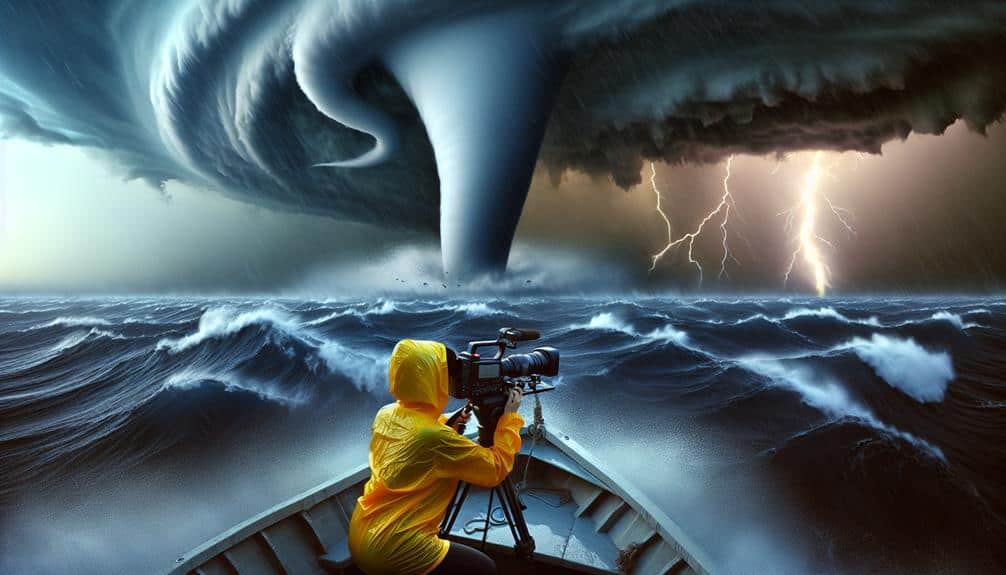We're drawn to waterspouts in extreme weather by a unique blend of scientific exploration and adrenaline. Real-time data on atmospheric pressure and sea surface temperatures sharpen our predictive models. The thrill of maneuvering through volatile conditions spikes our heart rates and escalates cortisol levels. High-definition cameras and drones capture high-resolution footage, offering fresh insights into waterspout dynamics. Our tight-knit community thrives on effective communication and shared experiences that push the boundaries of meteorological science. The combination of groundbreaking data collection and the sheer exhilaration of the chase keeps us coming back for more discoveries.
Key Points
- The adrenaline rush from navigating volatile waters and witnessing real-time meteorological dynamics.
- Scientific curiosity drives the meticulous analysis of atmospheric data and its applications in weather forecasting.
- Capturing unique high-resolution footage of waterspouts with advanced technology like drones and HD cameras.
- The thrill of maneuvering through turbulent conditions and the unpredictability of storm formations.
The Thrill of the Hunt
While chasing waterspouts, we experience an adrenaline rush that's quantifiable through increased heart rates and elevated cortisol levels. The thrill derives from a unique intersection of natural phenomena and ocean exploration.
As we steer our vessels through volatile waters, we observe a symphony of meteorological dynamics in real-time. The formation of waterspouts, driven by the interaction between warm sea surfaces and turbulent air masses, creates a spellbinding spectacle that demands our acute attention and precise maneuvering.
Our instruments record data that underscore the intensity of these experiences. Heart rate monitors frequently show spikes up to 30% above baseline, while cortisol assays reveal a significant uptick, indicating heightened stress and excitement. This physiological data aligns with our subjective experiences, making the pursuit of waterspouts both a scientific endeavor and an exhilarating adventure.
Freedom is an intrinsic part of this pursuit. We aren't confined by traditional research settings; instead, we embrace the open ocean, navigating through uncharted waters. The unpredictability of waterspouts adds an element of surprise, making each expedition unique.
This combination of natural phenomena and ocean exploration not only fuels our scientific curiosity but also satisfies our desire for unrestrained adventure.
Scientific Curiosity
Driven by an insatiable scientific curiosity, we meticulously analyze the meteorological data collected during our waterspout expeditions. This data serves as the foundation for understanding the complex meteorological phenomena that drive these awe-inspiring events. By examining variables such as atmospheric pressure, sea surface temperatures, and wind shear, we uncover patterns that might predict waterspout formation.
Each data point is a piece of the puzzle, offering valuable research opportunities that deepen our knowledge and refine predictive models. We leverage advanced technology, such as Doppler radar and satellite imagery, to capture high-resolution data. These tools allow us to track the development of waterspouts in real-time, providing insights into their lifecycle and behavior.
By correlating this information with historical data, we identify trends and anomalies that could signal future occurrences. Our analysis doesn't just stay within the confines of academic journals; it influences real-world applications, such as improving weather forecasting and enhancing public safety measures.
Our commitment to expanding the frontier of meteorological science is driven by the desire for freedom—freedom from the unknown, and the freedom to predict and prepare for nature's extremes. Through rigorous research, we transform curiosity into actionable knowledge.
Capturing Unique Footage
To capture unique footage of waterspouts, we deploy high-definition cameras and drones strategically positioned to document these phenomena from multiple perspectives. Our equipment is calibrated to capture the intricate details of storm formation, enabling us to gather extensive data.
By utilizing a variety of photography angles, we can analyze the waterspout's structure, rotational velocity, and interaction with the ocean surface.
Our drones provide aerial perspectives that are unattainable from the ground. These devices fly into the heart of the storm, capturing high-resolution images and video that reveal the dynamic processes propelling the waterspout. The footage collected is often analyzed frame-by-frame, allowing us to pinpoint the exact moments of peak intensity and structural changes.
Our focus on precise angles and high-quality equipment guarantees we capture every subtlety of the storm formation. This data is invaluable for advancing meteorological models and understanding the behavior of waterspouts.
Additionally, it allows us to share our findings with the broader scientific community and the public, promoting a deeper appreciation for the raw power of nature. By documenting these extreme weather events, we pave a way toward greater knowledge and freedom, unhampered by the unknown.
Adrenaline and Adventure
The thrill of chasing waterspouts stems from the raw power and unpredictability of these natural phenomena, providing an exhilarating experience that combines scientific inquiry with high-stakes adventure. We're drawn to the risky excitement of daring exploration, driven by the heart-pounding rush that comes with each wild discovery.
As storm chasers, we thrive on the precise analysis required to track and intercept waterspouts. The data we gather—wind speeds, rotation rates, and atmospheric conditions—fuels our understanding of these awe-inspiring events.
But let's be honest, it's not just the science that captivates us. The sheer force and beauty of a waterspout, twisting and churning over the open sea, evoke a sense of freedom and raw power that's hard to match.
Every chase carries inherent risks. Maneuvering through turbulent weather conditions demands split-second decisions and unwavering focus. Yet, it's this element of danger that heightens our senses and keeps us coming back for more.
The combination of scientific pursuit and the unpredictable nature of waterspouts creates a unique blend of adrenaline and adventure that's both thrilling and deeply fulfilling. In the end, it's about pushing the limits and experiencing the extraordinary.
Community and Camaraderie

Our shared passion for tracking waterspouts not only fuels our scientific pursuits but also forges a tight-knit community where camaraderie thrives. We operate as a unified team, each member bringing specialized skills and knowledge that enhance our collective understanding of these phenomena. This unity is rooted in our shared passion, driving us to collaborate seamlessly and support each other in the face of extreme weather.
Team dynamics play a vital role in our operations. We rely on effective communication and precise coordination to gather accurate data and guarantee safety. For instance, when monitoring a waterspout, real-time data exchange and strategic positioning are essential. Each team member has a designated role—whether it's data analysis, equipment handling, or navigation—ensuring that our efforts are synchronized.
The camaraderie extends beyond the field. We regularly engage in debriefing sessions to analyze data and refine our methodologies. These discussions often lead to innovations and improved strategies, further strengthening our bond. Additionally, social gatherings and shared experiences during downtime foster a sense of belonging and mutual respect.
In essence, our community thrives on shared passion and robust team dynamics, making our pursuit of waterspouts both scientifically rewarding and personally fulfilling.
Frequently Asked Questions
How Do Storm Chasers Ensure Their Safety During Waterspout Encounters?
We rely on meticulous safety precautions and robust emergency plans. Picture us monitoring radar data, calculating distances, and executing precise maneuvers. Our commitment to safety guarantees we can explore freely while minimizing risks during waterspout encounters.
What Equipment Do Storm Chasers Use to Track Waterspouts?
We use advanced tracking technology and communication methods to monitor waterspouts. Our equipment includes Doppler radar, weather balloons, and GPS, guaranteeing precise data collection. Safety precautions are essential, so we maintain constant communication to guarantee everyone's safety.
Are There Specific Regions Where Waterspouts Are More Common?
Ironically, it's not like waterspouts follow a strict schedule. However, global patterns and environmental factors influence their frequency and development, making regions like the Gulf of Mexico, Mediterranean Sea, and Great Lakes prime spots. Let's chase freedom!
How Do Waterspouts Differ From Tornadoes Over Land?
When discussing waterspouts vs tornadoes, we observe that their formation process differs notably. Waterspouts form over water and are generally less intense, while tornadoes form over land, originating from severe thunderstorms with stronger winds.
What Impact Do Waterspouts Have on Marine Life and Ecosystems?
We observe that waterspouts have significant marine impact, disrupting ecosystems by altering water temperature and salinity. These ecosystem effects can lead to changes in species distribution and potentially harm marine life, affecting biodiversity and food chains.


